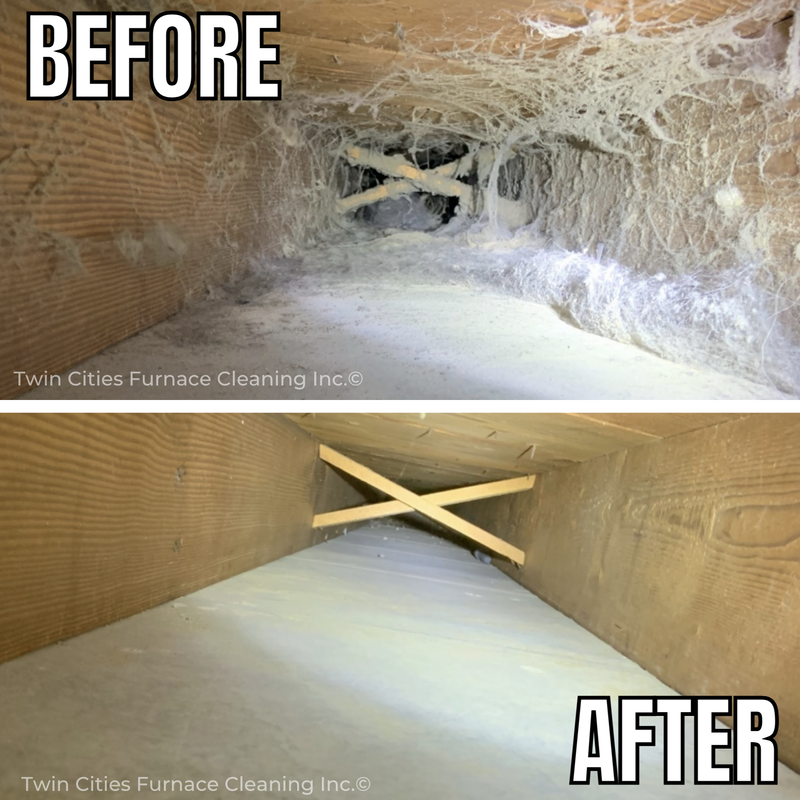|
The technician will begin attaching the vacuum hose to the ductwork near your furnace, the technician inserts a Viper Microline—a small but powerful air whip with a single powerful tentacle—into each vent, one at a time. The Microline features nozzle holes that exert forward air pressure, and as the technician slowly feeds the Microline into the vent, its tentacle thrashes around and physically dislodges debris, while at the same time the nozzle blows that debris toward the furnace, where the vacuum devours it.
In most cases it is not necessary to remove the register covers, as the Microline slips in between the fins of the register and easily down into the ducts. If, because of the distance between the fins or because of the slant of the registers, the Microline cannot get through, the technician will remove your registers. After creating negative air pressure throughout the duct system with the insertion of a powerful vacuum hose near your furnace, the technician services every vent in your home with a Viper Microline, which forces any debris down the branch lines and into the main trunk lines, where the Viper Clean Sweep System is later utilized to propel everything toward the vacuum. Every inch of the ductwork surface is contacted, as opposed to merely the surface downstairs. Down near your furnace, the Viper Clean Sweep is inserted into the main supply and the main return. This Viper utilizes six 14-inch long tentacles that thrash vigorously in every direction inside the duct. Once this tool is engaged, the finer, lighter debris becomes airborne and is sucked into the vacuum, and as the whip is slowly pulled through the ductwork, the tentacles pull the heavier debris toward the vacuum, ensuring nothing is left behind. To complete the process, the technician will clean your furnace. Normally sold as a separate service, furnace cleaning is included as part of the Ultimate Air Duct Cleaning. The majority of homes with dirty ductwork also have dirty furnaces, since the furnace essentially serves as the heart of the system. It is generally recommended that the furnace filter be replaced after air duct cleaning, but if a new filter is not immediately available, the technician can clean your existing one with air pressure (outside your home, of course!) until a new one can be obtained, typically within a week. This will also give the furnace time to cycle through any residual dust that may remain in the system. Want a simplified visual breakdown of the process? Click here.
0 Comments
During the Advanced Air Duct Cleaning, the beginning of the process is the same as for the Standard Air Duct Cleaning. The technician attaches an industrial vacuum hose (about 6 inches in diameter) to the ductwork near your furnace, creating negative air pressure throughout the ventilation and duct system. To do this, he creates an access point (a hole), using a drill and tin snips, that will later be covered with a piece of galvanized sheet metal (otherwise know as a cover plate). If you already have an appropriately positioned access point, he will use the existing one.
Once the access has been created and the vacuum is in place, the technician then services each supply and return vent with an air wand. This device has a nozzle approximately one foot long. It is pliable and fits in between the fins of the registers, exerting roughly 200 lbs. of air pressure. The technician is able to angle the air wand to force any dust and debris down the branch lines and into the main trunk lines. After the technician has serviced each of the vents with an air wand as described above, the Viper Clean Sweep is employed in the main supply and main return ducts. The Viper utilizes six 14-inch long tentacles that thrash vigorously in every direction inside the ducts, loosening debris from every nook and cranny and sending it down the main trunk and into the vacuum. The Viper is particularly effective in removing debris from the corners of the ductwork (where a rotary brush can sometimes miss), and is one of the most thorough duct cleaning tools available. It is generally recommended that the furnace filter be replaced after air duct cleaning, but if a new filter is not immediately available, the technician can clean your existing one with air pressure (outside your home, of course!) until a new one can be obtained, typically within a week. This will also give the furnace time to cycle through any residual dust that may remain in the system. During the Standard Air Duct Cleaning process, the technician attaches an industrial vacuum hose (about 6 inches in diameter) to the ductwork near your furnace, creating negative air pressure throughout the duct system. To do this, he creates an access point (a hole), using a drill and tin snips, that will later be covered with a piece of galvanized sheet metal (otherwise known as a cover plate). If you already have an appropriately positioned access point, he will use the existing one.
Once the access has been created and the vacuum is in place, the technician then services each supply and return vent with an air wand. This device has a nozzle approximately one foot long. It is pliable and fits in between the fins of the registers, exerting roughly 200 lbs. of air pressure. The technician is able to angle the air wand to force any dust and debris down the branch lines and into the main trunk lines. After all the registers and branch lines have been serviced, the technician moves to the main trunk lines, near your furnace. At this point, an air snake, with a reverse air nozzle, is utilized. In order to create access to these lines, one or more 1-inch holes (which will later be plugged with rubber duct plugs) are drilled into the main trunk line. The technician then inserts the air snake into each hole, one at a time, and, with the help of the reverse air nozzle, the air snake propels itself forward to the end of the trunk line. Then with the air pressure still engaged, the air snake is slowly pulled back toward the furnace, during which time it jostles around inside the trunk line, dislodging dust and debris and bringing it back toward the furnace, where our vacuum catches it. No mess involved! It is generally recommended that the furnace filter be replaced after air duct cleaning, but if a new filter is not immediately available, the technician can clean your existing one with air pressure (outside your home, of course!) until a new one can be obtained, typically within a week. This will also give the furnace time to cycle through any residual dust that may remain in the system. Once the technician is finished with the air duct cleaning process, he turns the furnace on to ensure everything is operating smoothly. Sometimes a slight burning smell can be observed when the furnace is first turned on as any residual dust is burned off. The New Year is the perfect time for a fresh start, literally. In the last couple of years, more and more people are spending most of their time in their homes. The U.S. Environmental Protection Agency lists poor indoor air quality as one of its top five health concerns. When you get an HVAC cleaning, you’re getting improved health, less stress on your HVAC units, reduced energy costs, and better air filter function. This year we challenge you to make your yearly resolutions with your home, family, and general well-being in mind.
Bring on the seasonal pies, cozy fires, and laughter. As the weather turns colder, we’re more thankful than ever to be contributing to your indoor health and comfort. There’s nothing like hearth & home.
HVAC stands for Heating, Ventilation, and Air Conditioning. HVAC cleaning is the process of using specialized tools to remove dirt, debris, and contaminants from the various components that make up a building’s HVAC system, either in a residential (home) or commercial (business) setting. Because your HVAC system is responsible for temperature regulation and air distribution within your home, it's cleanliness has a direct impact on the quality of the indoor air you breathe. Our HVAC cleaning services are all about keeping your home environment clean, healthy, and safe. Below are some of the benefits to you and your family of our air duct, furnace, chimney, and dryer vent cleaning services:
I know, I know, we keep extending our deals and promotions. But with the razzle dazzle of the summer season upon us, how could we not??? Snap up these deals before the season quickly changes. There may be very limited time for such savings (hint hint 👀 changes are around the corner).
It's officially summer!! Get out there and soak up the sun! Remember to cool off inside when needed! AC Cleanings are available to assist in beating that summer heat. Having your unit cleaned will help to ensure proper functioning when the warmer weather hits and your family's comfort depends on your AC running smoothly.
|
SearchArchives
April 2022
|
Twin Cities Furnace Cleaning - Open 7 Days a Week 8AM to 8PM










